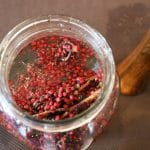Sumac just might be the toughest trees around. They’ve managed to adapt to the climates in every last one of the contiguous U.S. states, Mexico and Canada. In fact, they’re the ONLY shrub or tree species native to all 48 contiguous U.S. states! They’re incredibly drought tolerant (especially the cismontana variety) and are just as happy growing in a zone 3 as they are in zone 9. In fact, they seem to enjoy a challenge… they’re often found in the most inhospitable habitats of urban and rural areas alike — such as roadside embankments, rocky terrains, steep hills and country backroads.
Sumac is considered by some to be an invasive weed thanks to it’s talent for suckering and cloning itself rapidly. It’s a master colonizer and thicket former extraordinaire, so if you’re thinking about planting one in your backyard, it’s a good idea to either plant your sumac within a contained area or start sharping your pruning shears and loppers!

Sumac trees and shrubs (Rhus spp.), also known as red sumac and lemonade berry, are part of the Anacardiaceae family, which also includes cashew, mango and pistachio. The trees are quite attractive and produce striking conical berry clusters (or drupes) that mature throughout the summer, followed by deciduous leaves that turn a fiery red in the fall. Sumac’s flowers and fruits attract a wide assortment of birds, butterflies and pollinators.
Red sumacs are not to be confused with poison sumac. Fortunately, they don’t look even remotely similar. Poison sumac has differently shaped (rounder) leaves, red stems, large white berries and is typically found growing in wet, swampy areas. NON-poisonous sumacs have thin leaves, conical tiny red berry clusters growing at the tips of main branches and prefer dryer ground.
All parts of the red sumac tree have a long history in native American and traditional folk medicine of treating everything from UTIs to ringworm to bed wetting. The leaves are quite astringent and, prepared as an infusion (tea), are said to be useful in treating diarrhea, UTIs, cystitis and asthma, while a topical poultice made from the leaves may be useful in treating rashes.

Sumac bark is astringent, antiseptic, tonic, galactogogue (lactation stimulating), haemostatic (stops bleeding) and alterative. A syrup made from the bark has been used in alternative medicine to treat colds, stimulate the flow of breast milk, staunch bleeding and treat vaginal yeast infections. A poultice of the bark may be applied externally to treat burns and skin eruptions.
The berries have antimicrobial, diuretic, antiseptic, anti-inflammatory and vulnerary (wound healing) actions. They’re also loaded with vitamin C and antioxidants and have demonstrated blood sugar-regulating properties, making sumac a potentially good choice for diabetics. Gargling with an infusion/tea of sumac berries may be healing to a sore throat or mouth ulcerations. A wash made from the infusion is also said to be helpful in the treatment of ringworm.
Sumac berries are also useful in the adventurous cook’s kitchen. The berry drupes can be dried and ground into a spice powder that is commonly used to lend a lemon-like flavor to Arabic, Mediterranean, Turkish and Lebanese recipes such as fattoush, or sumac lamb chops or chicken shawarma. They’re also dead-handy on occasions when you discover half-way through making dinner that you’ve run out of lemons.
A cold-water infusion of the ripe berries produces a nutritious and refreshing lemon-like beverage sometimes called “sumac-ade” or “poor man’s lemonade.” You’ll know the berries are ripe when they’ve reached a deep velvety red/maroon color, usually in late summer. Besides making a great tasting beverage, sumac-ade packs some excellent nutrients including vitamin C, iodine, tannic, gallic and tartaric acids as well as trace minerals such as selenium.
Tough as they are, I’m hoping they’ll make themselves at home here in North Idaho, as I just finished planting four baby Rocky Mountain lemonade trees sumacs around our property! In addition to wanting free pink lemonade, I’m very much looking forward to the splash of color the sumacs will lend to our otherwise very green, alpine landscape. ♥
Alrighty, enough dilly-dallying. Let’s make some super-easy sumac pink lemonade!

Sumac Pink Lemonade
5 Stars 4 Stars 3 Stars 2 Stars 1 Star
No reviews
Ingredients
3–4 clusters of sumac (if you don’t have fresh, you can try using powdered sumac)
2 quarts quarts cold water
raw honey (optional)
Instructions
- Rinse sumac clusters and place inside a 2-quart mason jar.
- Fill to the top with 2 quarts of cool water. Be sure to use only cool/cold water, as hot water will release the berries’ tannic acid and your lemonade will become too bitter to drink.
- Secure the jar’s lid, and place in refrigerator; allow the berries to infuse overnight or up to 24 hours.
- Using a potato masher, a muddler or a sauerkraut pounder, press the berries a bit to release as much juice as possible.
- Strain liquid through a cheesecloth, a mesh strainer or a French press, and discard/compost the berries.
- Drink your sumac-ade straight up or sweeten with a bit of raw honey if you prefer a sweeter flavor. You can also try mixing it with a bit of tea for an herbal Arnold Palmer! ♥
Notes
Since sumac is related to cashews, pistachios and mangoes, anyone allergic to those foods should avoid eating it.


